the time bomb ticks
dan mackinlay: time machine, serial space
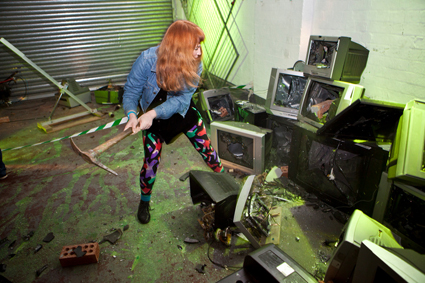
Age of Ease, Andrew McLellan, Lachlan Anthony, MIchael Candy, Time Machine exhibition
photo Alex Davies
Age of Ease, Andrew McLellan, Lachlan Anthony, MIchael Candy, Time Machine exhibition
THERE IS A WHISTLING GLISSANDO, THE PITCH SLIDING VERTIGINOUSLY DOWN OCTAVES. A FOLEY EFFECT FROM A WAR FILM PERHAPS, TO SIGNIFY A BOMB DESCENDING. THE DAMN THING NEVER SEEMS TO HIT US THOUGH AND I’VE BEEN HERE FOR HOURS WHILE THE WHISTLING GLIDES PERPETUALLY ON. IF IT IS A BOMB, THEN WE ARE SUSPENDED IN THE INSTANT BEFORE IMPACT.
I’m not speaking in metaphor here. The sound is not existential dread projected onto my tinnitus but bleed-through from an installation on the floor above us. Tim Bruniges’ audiovisual work, Continuum, is soundtracked by the classic auditory illusion, the eternally-descending Shepard–Risset glissando. The piece is soothing, if you stroll up the stairs for a look, all gentle blue-hued pixels. Downstairs, though: 100% harbinger of doom. The thing is, a bomb seems already to have hit the joint at least once—this place is half demolished. Last month’s hipster pop-up-performance decorations have been swept away in favour of undressed concrete. And that concrete is strewn with broken glass, splinters and dirt crowded into rude piles
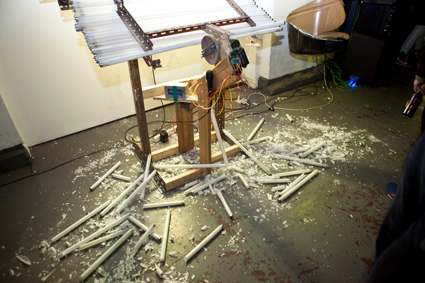
Age of Ease, Andrew McLellan, Lachlan Anthony, MIchael Candy, Time Machine exhibition
photo Alex Davies
Age of Ease, Andrew McLellan, Lachlan Anthony, MIchael Candy, Time Machine exhibition
Last night, this room had mechanical sculptures in it. An ammo clip of discarded fluorescent tubes fed a machine which smashed them, one at a time. Mechanical hammers, triggered by mobile phones in IED (improvised explosive device) fashion, wrecked glass at the behest of phone-toting punters. Last night’s intricate, sculptural demolition machines are today indistinguishable from their own by-products. They were, in turn, ravaged by more sophisticated, more destructive mechanisms: the audience. The opening night party-goers raged wild, atomising the lot: garbage, sculptures, whatever. This room of artful abandon, or, if you’d like, of wanton public health hazards, is called Age of Ease, a collaboration between Andrew McLellan, Lachlan Anthony and Michael Candy (featured in the realtime tv video on Psycho Subtropics). I don’t know if they intended this magnitude of destruction; you can’t engineer a riot necessarily, but you can put people in an environment where having one will be more rewarding for everyone.
Time Machine could not have chosen a more suitable opening night special. There is more than broken glass and anxious sound effects going on here. There is a punishingly full program of events encompassing performance lectures, tours, plain old concerts, workshops, Facebook theatre, debates, beer, essays and a generous supply of the miscellaneous across five venues plus the internet. It’s impressive. It’s impossible to see it all, or to summarise succinctly.
I don’t even know what ‘time-based art’ is, except for being the subject matter of the event. There seems to be something about transience and unrepeatability. Ephemerality is belligerently, intrusively present. The artworks are temporary, spontaneous; performance lectures and live gigs sure, but even the sculptures: take Creo Nova’s Genesis of Biosynthia for example, gratingly sonifying the random fluctuations in the flow of water through an assortment of pot plants.
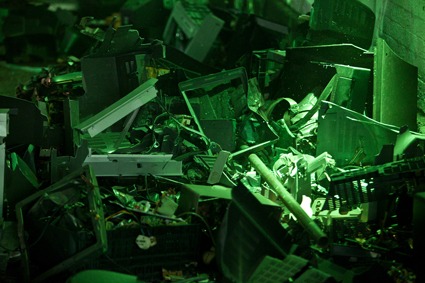
Age of Ease, Andrew McLellan, Lachlan Anthony, MIchael Candy, Time Machine exhibition
photo Alex Davies
Age of Ease, Andrew McLellan, Lachlan Anthony, MIchael Candy, Time Machine exhibition
More, the venues are themselves just as fleeting, like the main venue, Serial 002. Before Time Machine, it was the Queen Street Studios space on Kensington Street (Frasers to the brand-sensitive). A sop to the Richard Florida gang by the multi-billion dollar Central Park development—a lure to the creative classes—the space was born doomed to live for only four years. It was a den of rolling boutique wine bars, rampant rehearsals, temporary exhibitions and general celebrations of the precarity of creative practice (see interview with Queen Street team in RT91). It’s stripped of comfort for its ultimate appearance in this festival of entropy, unapologetic in art brut warehouse chic and peopled with the obstreperous destructive classes.
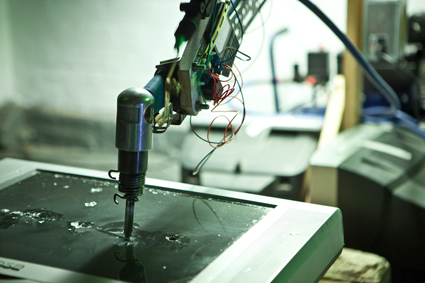
Age of Ease, Andrew McLellan, Lachlan Anthony, MIchael Candy, Time Machine exhibition
photo Alex Davies
Age of Ease, Andrew McLellan, Lachlan Anthony, MIchael Candy, Time Machine exhibition
In this fortuitous conjunction of public relations and schedule gaps, Serial Space’s curators have created an echo of the artist-run spaces that once dotted Chippendale, like a new media Brigadoon. The brief interval, of course, is utilised as an example for several sarcastic, thoughtful or vitriolic public presentations on the nature of the urban redevelopment that has housed us all for a moment and will evict us again in another. The Serial Space tram doesn’t just bite the hand that feeds it, they flense that hand and exhibit it in formaldehyde. Then they run a performance lecture about it.
No one is safe from their limit-testing mind. So I was tickled by the day-long sociological investigation that was the final Saturday’s programming. For that process, the broken glass room divided Serial 002 into two camps. In the far room, caged remote-controlled robot fights all day. Truly, there is such a thing as an international league of robo-warriors and the local chapter of Robowars is run by a chap from Pymble, Angus Deveson. He has put this battle on, not to mention a week of solder-heavy workshops in the lead-up. The competitors are mostly (or all) male and the smell of sweaty boy bedroom commingles with overheated electric motors in a den of technology-mediated violence. In the room near the front door, a program of panels and presentations run entirely by women, discussing, say, “the relationship between women and technology,” or a retrospective of Bonita Ely’s mythic Dogwoman performances.
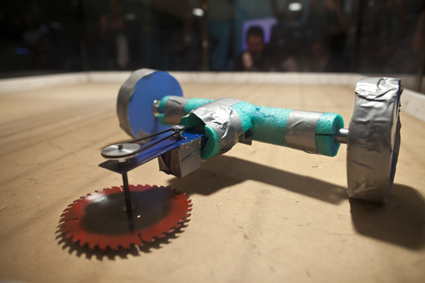
Robowars, Time Machine
photo Alex Davies
Robowars, Time Machine
More fascinating than the content of either half of this programming is the social divide. The front row of the robowars thing is rife with teenage girls, for one thing, who don’t feel a need to voice their opinion on the relationship between women and technology. At the back of audience of the panels a couple of attendees are sneaking back and forth to check on their favoured death machine’s performance in the semi-finals as those who like to talk about their art and those who prefer to watch it destroy itself vie for time and acoustic space.
And all the while you can hear in the background that damn bomb that is about to land on us. It is trademark Serial Space, this cheeky, disruptive intervention. There’s not a neat take-home moral at the end for us all, just a deftly engineered, intriguing experience that you can’t really repeat, which I suppose is the point.
Time Machine, curated by Serial Space: Frances Barrett, Kate Blackmore, Jennifer Hamilton, Tom Smith and Pia van Gelder; July 18-29; http://serialspace.org/events/event/time-machine/
This article originally appeared in RT’s online e-dition august 2.
from the serial space team
Time Machine was the first collective curatorial project that involved all the Serial Space directors in one activity. We wanted to expand from our regular programming and aim towards building a collective vision and identity as Serial Space. We are so proud of what we achieved over the two weeks of Time Machine and so grateful for all the artists who contributed. From our point of view, the success of Time Machine has made us realise that our identity isn’t confined to the space. It made us look beyond this space, as a curatorial collective. We want to develop the vision that we realised in Time Machine and to do that we have decided to take a huge risk. The risk is that Serial Space is moving out of 33 Wellington Street.
We did not intend this to be the outcome of Time Machine, and in no way does it mean that Serial Space is no more. But it is the most logical time for Serial Space to change direction. In the next few months the collective will undertake a series of independent residencies and research endeavours. During this time we will also cut our ties to a particular space and look towards an exciting future. We will continue to have sporadic Serial Space events for the rest of 2012 and we look forward to starting up again February 2013 in a whole new way.
Serial Space team: Frances Barrett, Kate Blackmore, Jennifer Hamilton, Tom Smith and Pia van Gelder; email correspondence, August 10, 2012
RealTime issue #111 Oct-Nov 2012 pg. 28






